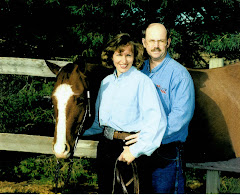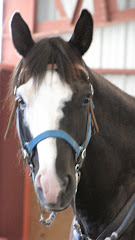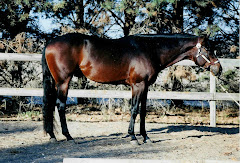FRIDAY, October 1, 2010
I took 2 horses to the Peter Campbell clinic. One was Duster, a 2 year old that hasn’t left the place until today. He’s only been saddled for the last 3 weeks, being ground driven, lunged with the saddle on, but didn’t have any riding. The other is Shaggy, a 7 year old gelding that I have given about a month of riding each year since he was 3. This year, I started riding him regularly since May. He needs to move better off my legs. Both of these young horses are by my Stud, Duke, a son of Good Asset.
Duster is my 2 year old. He is extremely bully and pushy. A big puppy dog who is gentle, but had a mother who was herd mare, at least for the last 5 years. Duster isn’t scared of the older geldings. He just walks among them and pushes into between them at the feeders.
Duster: He was to move around me, turn from side to side, turn between me and the wall. He was to stay back away from me and not push into me. He was to pay attention to me and not to all of the commotion in the arena.
I’m glad that Duster is a quiet guy, because he came into the arena with his head up and ears perked and snorting. Where did all of this come from? He heard the cows next to the arena being fed. They couldn’t be seen but he wasn’t too bothered by that. Then a water sprinkler was wetting down the small arena on the other side of the ¾ cement wall that separated the 2 walls. The was hitting the wall, making that spritzing sound. Duster has heard the water sprinkler before, but hearing it and not seeing it was 2 different things. His mind was on that instead of me.
I started to lunge him while Peter was talking to the group. He didn’t want us to wear our horses down to get their minds, but to make them change directions on the lunge line instead, with the aid of a flag attached to a short whip. I had to move from the end of the arena to a spot on the long wall so I could work him.
Duster had to have a major attitude adjustment on the first day of the clinic. With the help of a short stick/whip with a flag attached to it, we were to make the horse move around us in a circle, and then stop and turn. We worked on moving the horse’s hips and shoulders. We worked on moving the horse’s body away from us. Duster still didn’t like all the noises. Peter said that, to get his mind, make him move where I wanted him to move and when I wanted him to move. I was not doing a good job with getting Duster to move away from me with the bag/flag. Duster knows how to lunge, but that first day, he didn’t want to stop, or turn, or move where he was suppose to. I was starting to sweat. He was being the bad kid in school! Peter came over and asked if he could work with him. I said of course, Peter wanted a YES, and Duster went to school. He graduated with more manners. I was able to do the same work with him. Duster had learn to respect the stick with the flag, to respect the lead rope and to move his body where it should go.
Duster ended the day more respectful and more quiet than he started the day. He learned to move his hips and that was the start of having him pay attention to me and not to everything else that was going on. He stayed at the end on a relaxed lead rope. When I moved, he turned his body to follow me with his eyes. The exercise that Duster had to learn was to actually move his hips, crossing his hind legs when he moved them, therefore freeing up his hips more.
Shaggy: Walking out, getting the walk as fast as you can. Extend the trot. Walk or stop with lightness.
During the afternoon session, I rode Shaggy. We did a LOT of walk, trot, extended trot, walk, stop transitions. The main emphasis was on stopping light and giving to the bit. We were to walk and pick up a light feel on the reins, asking the horse to soften. When the horse softens, he will lower and tuck the jaw to the inside. If there is any resistance or pull against the reins, adding more leg to get the horse to move forward.
It is important that, when the horse hardens and pulls on the reins, you have the horse pull against himself and do not pull back. Be ready to soften your hold on the reins the moment the horse softens. Shaggy did well the first day until we picked up a trot. I usually ride in a shank bit, with a covered broken mouthpiece, and he gives beautifully to that type of bit. In a snaffle with no leverage, there was more resistance. At the trot, he was beginning to throw his head up to evade the bit. I kept the hold on the bit steady with my hands, and left him to figure out where to put his head. We will be working on this for the next 3 days.
Peter asked us to walk out, and walk out faster. We were to get the horse to move out a walk and ask for the fastest walk that we can get, until right before the horse would break in to a trot. We did many walk trot transitions. We stopped after asking for a lightness on the bit first. We walked one or 2 steps, then trotted. We asked for a long extended trotting, with a long rein. We asked for walk and/or a stop with lightness. That took some thinking to stop the horse, without the horse throwing out his jaw or lifting his head. As you slow down from the extended trot to a slow trot, then to the walk, and right into the stop, you are asking the horse to give to the bit, lowering the jaw, and stopping with the head and neck level.
We worked in pairs and walked, trotted and loped circles around our partner. This was a fun exercise. I was paired with a beautiful Friesen stallion, and didn’t know he was a stud until the next day! He was a delight to be around. We walked circles and half circles. With each half circle, the horse to the inside went to the outside. The outside horse had to trot when the inside horse walked, and he had to lope when the inside horse trotted. We were to stay even with each other, without letting one horse get ahead or behind the other. We were to make our own circle, paying attention to keep our own horse light, yet stay together. This exercise seemed like it shouldn’t have been easy to do, but after many circles and half circles at the walk and trot, we were able to do the lope circle easily. I was amazed at how light and easily Shaggy did the lope circles. That was his best, collected loping to date!
Shaggy got lighter and lighter as the day went on. I still had resistance on the bit at the trot, but he did soften each time. I know he doesn’t like the bite of the bit on his tongue, but as my hands stay light, and he pulls against himself, he will soon realize that he is causing that discomfort himself. Stay light, ask for a softness, and the horse will respond.
I think the tiredness, that I was feeling after the first day, comes from total concentration of what we were working on. That, and traveling back and forth with 2 horses. I was going to stall them every night, but I didn’t want them standing in a stall from 4 pm to 8 am. They loaded easily so I took them home to be outside in their outside lots for the evening and night. I know that would keep them relaxed for the next day’s work. After their workouts, I’m sure they needed to relax their minds and bodies too.
Turning Night to Day
9 years ago







No comments:
Post a Comment